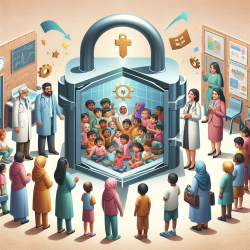Introduction: The Power of Interprofessionalism in Decision-Making
In the realm of healthcare, particularly in speech-language pathology and related services, the importance of collaborative decision-making cannot be overstated. The traditional models of shared decision-making (SDM) often focus on the patient-physician dyad, which may not fully encompass the complexities of modern, interdisciplinary healthcare. The research article "Interprofessionalism and shared decision-making in primary care: a stepwise approach towards a new model" by Légare et al. (2011) presents a groundbreaking model that integrates interprofessionalism into SDM, offering a comprehensive framework that could significantly enhance outcomes for children in primary care settings.
The Integrated Interprofessional SDM Model
The interprofessional shared decision-making (IP-SDM) model introduced in the study is a multi-level framework designed to incorporate various healthcare professionals in the decision-making process. This model operates on three levels:
- Individual (Micro) Level: Focuses on the patient and their immediate healthcare team, ensuring that decisions are made collaboratively with input from multiple professionals.
- Healthcare System (Meso) Level: Acknowledges the roles of organizational routines and the influence of team dynamics on decision-making processes.
- System (Macro) Level: Considers broader influences such as health policies and professional organizations that impact the decision-making environment.
Why This Model Matters for Children's Outcomes
Children, especially those receiving speech-language pathology services, benefit immensely from an interprofessional approach to care. This model ensures that decisions are not only patient-centered but also informed by a diverse range of professional perspectives. By integrating insights from various disciplines, the IP-SDM model fosters a more holistic approach to care, potentially leading to improved developmental outcomes for children.
Implementing the IP-SDM Model: A Stepwise Approach
For practitioners looking to enhance their decision-making processes, adopting the IP-SDM model involves several key steps:
- Understanding the Model: Familiarize yourself with the three levels of the IP-SDM model and how they interact.
- Building a Collaborative Team: Assemble a team of professionals from diverse disciplines who can contribute to the decision-making process.
- Engaging with Stakeholders: Involve patients and their families in discussions to ensure that decisions reflect their values and preferences.
- Evaluating and Adapting: Continuously assess the effectiveness of the model in practice and make adjustments as necessary to improve outcomes.
Encouraging Further Research and Practice
The IP-SDM model is a promising step towards more integrated and effective healthcare delivery. However, it is essential for practitioners to engage in ongoing research and practice to validate and refine the model. By participating in collaborative research initiatives and sharing experiences, healthcare professionals can contribute to the evolution of interprofessional decision-making models.
To read the original research paper, please follow this link: Interprofessionalism and shared decision-making in primary care: a stepwise approach towards a new model.










